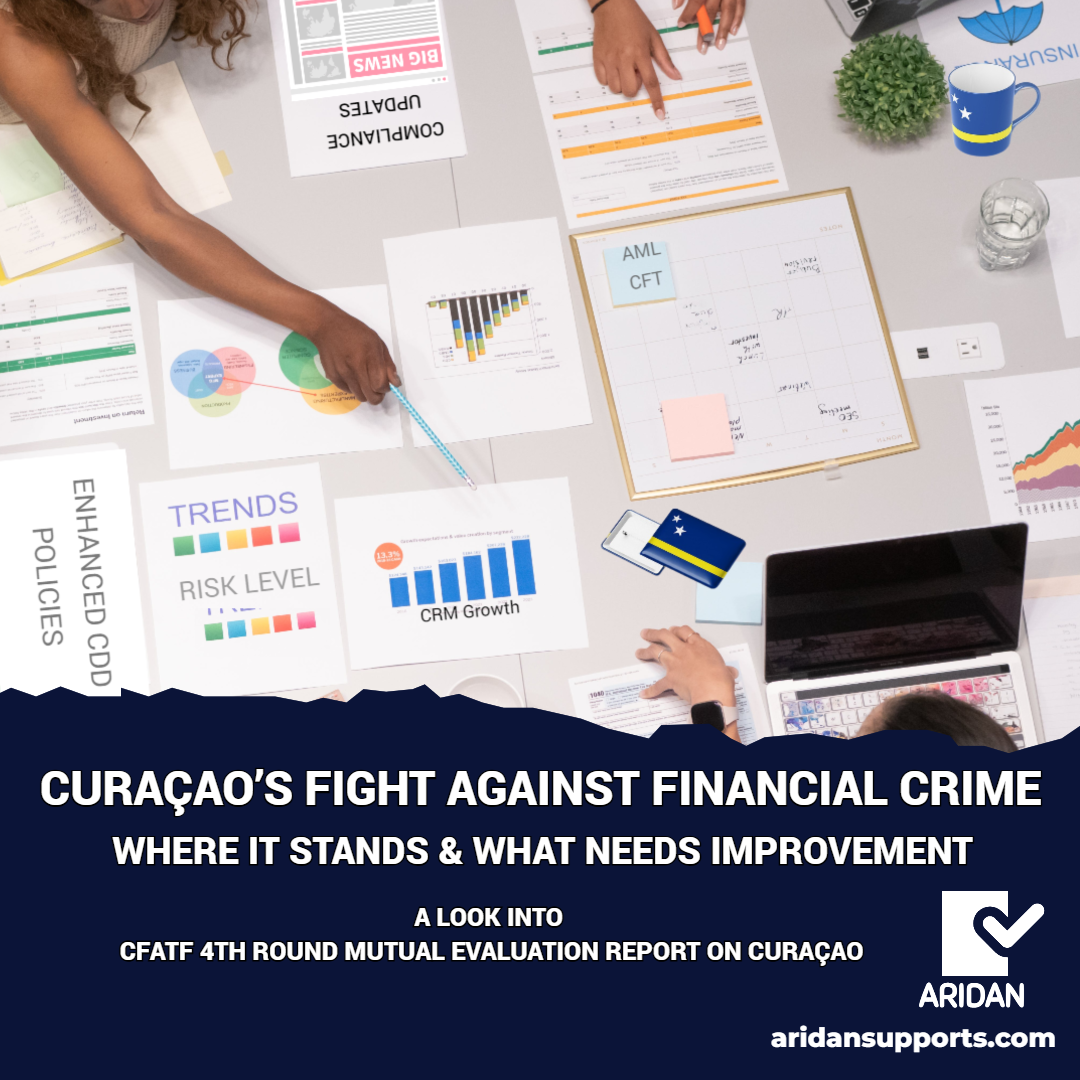The upcoming Caribbean Financial Action Task Force (CFATF) Mutual Evaluation (MEVAL) in 2024 is a crucial assessment that will assess Curaçao’s adherence to international standards in the fight against money laundering, terrorism financing, and the proliferation of weapons of mass destruction.
It is imperative to acknowledge the indispensable role the private sector plays in this process. Not favorably passing the assessment would mean having the country on the Financial Action Task Force on Money Laundering (FATF) grey list or black list.
CFATF is an organization of Caribbean states and territories agreeing to implement common countermeasures against money laundering. CFATF has an associate status within the FATF.
The onsite MEVAL is planned for June 2024. Before the onsite evaluation, the evaluation of technical compliance is planned for December 2023, and the evaluation of effectiveness is planned for February 2024 (CBCS. 2023. b).
THE FATF
The FATF, an intergovernmental organization with 39 members, is the developer of worldwide standards for combating money laundering, and the financing of terrorism and proliferation. The FATF was established by the G-7 Summit in Paris in 1989 and works in close cooperation with other key international organizations, including the IMF, the World Bank, and the United Nations. There are also nine FATF-style regional bodies (FSRBs) that, in conjunction with the FATF, constitute an affiliated global network to combat money laundering and the financing of terrorism.
The primary mechanism is through its set of 40 recommendations, otherwise known as the FATF Recommendations. These provide a framework of measures that countries should implement to counter money laundering and terrorist financing through their legal, administrative, and operational frameworks.
All FATF and FSRB member countries are regularly subjected to so-called Mutual Evaluations (MEVALs). The FATF conducts MEVALs of its members’ levels of implementation of the FATF Recommendations on an ongoing basis. These are peer reviews, where members from different countries assess another country. The FATF Methodology for assessing compliance with the FATF Recommendations and the effectiveness of AML/CFT systems sets out the evaluation process. During an evaluation, a team of experts from other countries assesses a country’s national anti-money laundering and terrorist financing combating regime. The results are laid down in MEVAL reports.
THE CBCS
Money laundering and terrorist financing cannot be fought in isolation. Governments, public authorities, and the private sector all have a role to play. The Centrale Bank van Curaçao en Sint Maarten (CBCS) is responsible for, among others, the Anti-Money Laundering and Countering the Financing of Terrorism and proliferation (AML/CFT/CFP) regulation and the supervision of the financial services sector in Curaçao and Sint Maarten. As part of its regulatory function, the CBCS issues legislation and guidelines such as the AML/CFT/CFP Provisions & Guidelines (P&Gs) some of which have been currently updated.
Supervised institutions include in addition financial institutions (such as banks and insurance companies), securities intermediaries, asset management companies, trust service providers, and external auditors. Supervised institutions are required to duly observe these AML/CFT/CFP Provisions & Guidelines (P&Gs) and take the required actions to be compliant.
Following the National Ordinance on the Reporting of Unusual Transactions (N.G.1 2017, no. 99 C.T.) and the National Ordinance on Identification of Clients when Rendering Services (N.G. 2017, no. 92 C.T.) as well as the Sectoral Supervisory National Ordinances, the CBCS has the authority to impose sanctions on the supervised financial institutions that do not fully or timely comply with the obligations outlined in these legislations. A country must have a robust AML/CFT/CFP regulatory framework as it dissuades criminals from targeting the financial system of that country (CBCS, 2023. a).

THE PRIVATE SECTOR: IMMEDIATE OUTCOME 4
The effectiveness of the regulatory framework can be significantly reinforced through the active involvement and cooperation of the private sector. For the private sector, the CFTAF will focus on Immediate Outcome 4 (IO4) – “Preventive Measures” which in turn is supported by FATF Recommendations 9-23.
IO4 emphasizes the importance of effective supervision and regulation of the private sector, including financial and non-financial service providers, to combat money laundering and terrorist/proliferation financing. The private sector plays a critical role in this process and must adopt comprehensive strategies to comply with IO4 effectively.
As a regulated entity, you should consider the preventive measures contained within IO4. These measures serve as a critical roadmap for what CFATF Assessors will scrutinize when evaluating the compliance and effectiveness of the private sector (CIFA, 2023).
WHY ARE PREVENTIVE MEASURES IMPORTANT?
Preventive measures are important to effectively protect the business, sectors, and financial systems from misuse and abuse by criminal networks through sound identification and understanding of money laundering and terrorist financing risks and strong and appropriate application of client due diligence, record keeping, internal control, and reporting requirements. The core issues of preventive measures that need to be dealt with consist of supervised institutions answering the following questions (CFATF GAFIC. 2020):
- How well do you understand your Money Laundering/Terrorist Financing/Proliferation Financing risks and AML/CFT/CFP obligations?
- How well do you apply mitigating measures commensurate with your risk?
- How well do you apply the CDD and record-keeping measures and to what extent is business refused due to incomplete CDD?
- How well do you apply enhanced or specific measures for Politically Exposed Persons (PEPs), correspondent banking, new technologies, wire transfer rules, targeted financial sanctions, and higher-risk countries?
- To what extent do you meet your reporting obligations on the suspected proceeds of crime and terrorism funds? What are the practical measures to prevent tipping off?
- How well do you apply internal controls and procedures to ensure compliance with AML/CFT/CFP requirements? Which legal or regulatory requirements are impeding its implementation?
THE GREY LIST AND THE BLACK LIST
When the FATF places a country or jurisdiction under the increased monitoring list, it means the country has committed to resolving swiftly the identified strategic deficiencies within agreed timeframes and is subject to increased monitoring. This list is often externally referred to as the grey list.
Countries or jurisdictions with serious strategic deficiencies to counter money laundering, terrorist financing, and financing of proliferation are identified as high-risk (black list). For all countries identified as high-risk, the FATF calls on all members and urges all jurisdictions to apply enhanced due diligence, and in the most serious cases, countries are called upon to apply counter-measures to protect the international financial system from the ongoing money laundering, terrorist financing, and proliferation financing risks emanating from the country.
THE CONSEQUENCES
Both the grey list and the black list are openly published by the FATF and regularly updated. Being publicly identified on the grey list could have negative economic and reputational consequences according to Koker et al. (2023), which may impact the financial sector and international financing and aid such as:
- Governments may tighten the regulation of trade with the listed country, or with connected entities, or even prohibit business.
- Firms in, or linked to, the listed country (e.g., by ownership or trade) may need to undertake more checks to comply, and be seen to be complying, with regulations resulting in changes in aggregate volume, variety, quality and cost of goods and services may impact national profitability.
- Greylisting has consequences for both domestic and international financial institutions. Morse found that the FATF grey list is a powerful driver of policy change as market actors (predominately banks) use the list to allocate resources away from non-compliant states. This is due to higher customer due diligence regulations from banks, which often rely on the FATF grey and black lists as important sources of information that may protect them from being involved with financial integrity scandals (Morse, J, 2019).
- The authors (Koker et al., 2023) found a significant correlation between FATF grey listing and a reduction in development assistance. They argue that these punitive measures run counter to the messaging that the FATF provides, that greylisting does not require official sanctioning or due diligence measures by other countries.
- Direct aid may fall as donors negotiate measures to address the new risk profile that greylisting gives rise to. The authors note that greylisting creates a period of uncertainty, during which officials are hesitant to commit to loans.
- Being placed on the FATF grey list raises the possibility of being moved to other Anti-Money Laundering and Countering the Financing of Terrorism (AML/CFT) grey lists. The European Union’s (EU) policy on high-risk third countries (recently updated to Delegated Regulation concerning third countries that have strategic deficiencies in their AML/CFT regimes) has what has been referred to as “informal synergies” with the FATF grey list (Pavlidis, G, 2022).
Perhaps the consequence of the greatest impact is the risk of being moved to the FATF blacklist. Not only does blacklisting entail further reputational damage to a country, FATF member states are expected to impose penalties and other restrictive measures.
International bodies such as the IMF, World Bank, and Asian Development Bank apply restrictive measures too. This creates a risk of a further reduction or even a stop in international aid and financial assistance for the blacklisted country (Shah, A.R, 2021). The examples of countermeasures that countries could implement on the blacklisted include (among others):
- Requiring financial institutions to apply specific elements of enhanced due diligence.
- Introducing enhanced relevant reporting mechanisms or systematic reporting of financial transactions Refusing the establishment of subsidiaries or branches or representative offices of financial institutions from the country concerned, or otherwise taking into account the fact that the relevant financial institution is from a country that does not have adequate AML/CFT systems.
- Limiting business relationships or financial transactions with the identified country or persons in that country.
- Requiring increased supervisory examination and/or external audit requirements for branches and subsidiaries of financial institutions based in the country concerned (FATF 2023 Recommendations Interpretive notes 18 1c: p86).
FINAL THOUGHTS
To achieve a successful CFATF evaluation regulated entities must integrate a multifaceted approach encompassing regulatory compliance, robust risk management, enhanced customer due diligence, vigilant transaction monitoring employee training, and collaboration with stakeholders (CIFA, 2023).
In simple terms, what this means for supervised institutions is for example the review and update of compliance policies and procedures, a review of client files, and maybe an update of the training program. The expected trend is to see many of the supervised intuitions digitizing their compliance process. Non-supervised institutions could follow the example and at the least collect the basic documents when working with businesses and individuals. Hereby is an example of a basic Know Your Client (KYC) checklist.
Implementing these best practices will not only support compliance efforts but also actively contribute to a safer and more resilient global financial system. A successful evaluation is of utmost importance for the current and future endeavors to further work on the economic development of the country.
Sources
CBCS. 2023. a Fact sheet Money Laundering and terrorist financing. Accessed December 8, 2023.
CBCS. 2023. b Training session 2024 Mutual Evaluation Curaçao. Accessed December 8, 2023.
CIFA. 2023. Preparing for a successful CFATF Mutual Evaluation. Accessed December 8, 2023.
CFATF GAFIC. 2020. Immediate Outcome 4 – “Preventive Measures” To what extent FIs, DNFBPs, and VASPs adequately apply AML/CFT preventive measures commensurate with their risks, and report suspicions of transactions. Accessed December 8, 2023.
FATF. 2023. Black and Grey Lists. Accessed December 7, 2023.
FATF. 2023. FATF Methodology for assessing compliance with the FATF Recommendations and the effectiveness of AML/CFT systems. Accessed December 7, 2023.
Koker, L. et al. 2023. Economic consequences of greylisting by the Financial Action Task Force. Accessed December 7, 2023.
Morse, J. 2019. Blacklists, market enforcement, and the global regime to combat terrorist financing. International Organization 73.3. Accessed December 7, 2023.
Pavlidis, G. 2022. Journal of Financial Crime 28 (2021)(3): 765-773 Financial Action Task Force and the Fight against Money Laundering and the Financing of Terrorism: Quo Vadimus?. Accessed December 7, 2023.
Shah, A.R. 2022. The geopolitics of Pakistan’s 2018 greylisting by the Financial Action Task Force. Accessed December 8, 2023.
U4 Helpdesk Answer. 2023. The impact of greylisting by the Financial Action Task Force (FATF). Accessed December 8, 2023.











